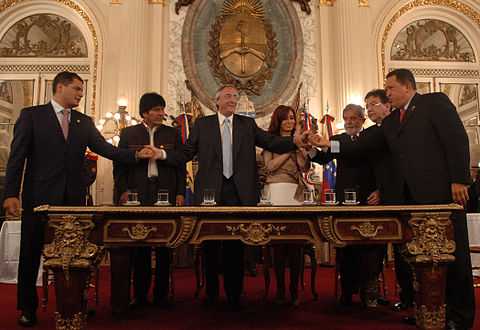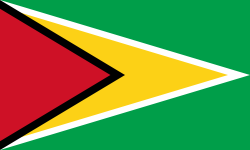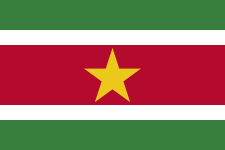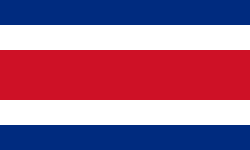Pink tide

Pink tide (Spanish: marea rosa, Portuguese: onda rosa) or Turn to the Left (Sp.: vuelta hacia la izquierda, Pt.: Guinada à Esquerda) are phrases used in contemporary 21st century political analysis in the media and elsewhere to describe the perception that leftist ideology in general, and left-wing politics in particular, are increasingly influential in Latin America.[1][2][3]
In 2005, the BBC reported that out of 350 million people in South America, three out of four of them lived in countries ruled by "left-leaning presidents" elected during the preceding six years.[2] According to the BBC, "another common element of the 'pink tide' is a clean break with what was known at the outset of the 1990s as the 'Washington consensus', the mixture of open markets and privatisation pushed by the United States".[2]
The Latin American countries viewed as part of this ideological trend have been referred to as "Pink Tide nations".[4] The term Post-neoliberalism has been used as a term to refer to the Pink Tide.
Use of the term
While being a relatively new coinage, the term "pink tide" has become prominent in contemporary discussion of Latin American politics. Origins of the term may be linked to a statement by Larry Rohter, a New York Times reporter in Montevideo who characterized the election of Tabaré Vázquez as leader of Uruguay as "not so much a red tide…as a pink one."[3] The term seems to be a play on words based on "red tide" (a biological phenomenon rather than a political one) with "red" – a color long associated with communism – being replaced with the lighter tone of "pink" to indicate the more moderate communist and socialist ideas gaining strength.[5]
According to a 2006 press release from the Council on Hemispheric Affairs, a left-leaning Washington, D.C.-based non-governmental organization:
| “ | …the Washington rumbles with suppressed outrage over Latin America's latest professions of its sovereignty – Bolivia's nationalization of its oil and natural gas reserves, and Ecuador and Venezuela's voiding of their energy contracts. At the same time, Bolivia's newly inaugurated president, Evo Morales, is a prime candidate to join Washington's pantheon of Latin American bad boys, presently represented by Fidel Castro and Hugo Chávez. Meanwhile, the region's new populist leadership, also known as the "Pink Tide", extends its colors across South America and is poised to leap to much of the rest of Latin America. Ostensibly, the "pink tide", consists of left-leaning South American governments seeking a third way to register their political legitimation to their citizens, as well as their autonomy regarding such foreign policy issues as Iraq.[6] | ” |
According to Diana Raby from Red Pepper Blog:
| “ | …with left-wing victories in Venezuela, Brazil, Uruguay, Bolivia, Ecuador and Nicaragua, social and economic recovery in Cuba and popular advances elsewhere in the region, journalists are talking about "Latin America's pink tide" and the region itself has become the forum for passionate debates on "Socialism of the 21st Century".[7] | ” |
More recently one observer wrote that as "the so-called 'Pink Tide' sweeps through South America", 2009 will probably see the election of Mauricio Funes in El Salvador.[8] However, despite the presence of a number of Latin American governments which profess to embracing a leftist ideology, it is difficult to categorize Latin American states "according to dominant political tendencies, like a red-blue post-electoral map of the United States."[5] According to the Institute for Policy Studies, a liberal non-profit think-tank based in Washington, D.C.:
| “ | …a deeper analysis of elections in Ecuador, Venezuela, Nicaragua, and Mexico indicates that the "pink tide" interpretation—that a diluted trend leftward is sweeping the continent—may be insufficient to understand the complexity of what's really taking place in each country and the region as a whole.[5] | ” |
While this political shift is difficult to quantify, its effects are widely noticed. According to the Institute for Policy Studies, 2006 meetings of the South American Summit of Nations and the Social Forum for the Integration of Peoples demonstrated that certain discussions that "used to take place on the margins of the dominant discourse of neoliberalism, (have) now moved to the center of public debate."[5]
Reaction
The perception of the rising pink tide is heralded as welcome change by those sympathetic to the views it represents while those near the opposite end of the political spectrum identify it as a malignant influence. According to the latter:
| “ | The Bush administration, now led by the State Department's Secretary Rice, and the Pentagon, by Defense Secretary Rumsfeld, had no problem accusing these left leaning governments, led by Hugo Chávez, of being threats to the U.S. national interest and of being destabilizing factors to other Latin American countries, even though they could never quite identify the source of that threat.[6] | ” |
According to a report from the Inter Press Service news agency:
| “ | …elections results in Latin America appear to have confirmed a left-wing populist and anti-U.S. trend – the so-called “pink tide” – which, along with the recent disclosures regarding ties between right-wing paramilitaries and the government of Colombian President Álvaro Uribe, poses serious threats to Washington's multi-billion-dollar anti-drug effort in the Andes.[9] | ” |
Decline
As of 2014, conservative parties are still weak in Latin America, but left-wing leaders had begun to shift to centrism. The death of Hugo Chávez left the most radical wing without a clear leader, as Nicolás Maduro does not have the same international influence of his predecessor. National policies are divided between the styles of Chávez and Lula da Silva, as Lula focused on the poor people but also in private enterprises and global capital.[10]
Far-left, Center-left, and Left-wing presidents in Latin America
Note: Center-left presidents are marked with *
 Cuba: Fidel Castro (1976–2008), Raul Castro (2008–present) Note: both Cuban presidents as Marxists-Leninists are Far-left politicians.
Cuba: Fidel Castro (1976–2008), Raul Castro (2008–present) Note: both Cuban presidents as Marxists-Leninists are Far-left politicians. Venezuela: Hugo Chávez (1999–2013), Nicolás Maduro (2013-present)
Venezuela: Hugo Chávez (1999–2013), Nicolás Maduro (2013-present) Chile: Ricardo Lagos* (2000–2006), Michelle Bachelet* (2006–2010, 2014–present)
Chile: Ricardo Lagos* (2000–2006), Michelle Bachelet* (2006–2010, 2014–present) Brazil: Luiz Inácio Lula da Silva* (2003–2011), Dilma Rousseff* (2011–present)
Brazil: Luiz Inácio Lula da Silva* (2003–2011), Dilma Rousseff* (2011–present) Argentina: Néstor Kirchner* (2003–2007), Cristina Fernández de Kirchner* (2007–present)
Argentina: Néstor Kirchner* (2003–2007), Cristina Fernández de Kirchner* (2007–present) Dominican Republic: Leonel Fernández* (1996–2000, 2004–2012), Danilo Medina* (2012–present) [11]
Dominican Republic: Leonel Fernández* (1996–2000, 2004–2012), Danilo Medina* (2012–present) [11] Guyana: Cheddi Jagan (1992–1997), Sam Hinds (1997), Janet Jagan (1997–1999), Bharrat Jagdeo (1999–2011) and Donald Ramotar (2011–present)
Guyana: Cheddi Jagan (1992–1997), Sam Hinds (1997), Janet Jagan (1997–1999), Bharrat Jagdeo (1999–2011) and Donald Ramotar (2011–present) Suriname: Jules Wijdenbosch (1996–2000), Dési Bouterse (2010–present)
Suriname: Jules Wijdenbosch (1996–2000), Dési Bouterse (2010–present) Uruguay: Tabaré Vázquez* (2005–2010, 2015-present), José Mujica* (2010–2015)
Uruguay: Tabaré Vázquez* (2005–2010, 2015-present), José Mujica* (2010–2015) Bolivia: Evo Morales (2006–present)
Bolivia: Evo Morales (2006–present) Nicaragua: Daniel Ortega (1979–1990, 2007–present)
Nicaragua: Daniel Ortega (1979–1990, 2007–present) Ecuador: Rafael Correa (2007–present)
Ecuador: Rafael Correa (2007–present) Guatemala: Álvaro Colom* (2008–2012)
Guatemala: Álvaro Colom* (2008–2012) Paraguay: Fernando Lugo (2008–2012)
Paraguay: Fernando Lugo (2008–2012) El Salvador: Mauricio Funes* (2009–2014), Salvador Sánchez Cerén* (2014-present)
El Salvador: Mauricio Funes* (2009–2014), Salvador Sánchez Cerén* (2014-present) Honduras: Manuel Zelaya* (2006–2009[12])
Honduras: Manuel Zelaya* (2006–2009[12])  Peru: Ollanta Humala* (2011–present)
Peru: Ollanta Humala* (2011–present) Costa Rica: Luis Guillermo Solís* (2014–present)
Costa Rica: Luis Guillermo Solís* (2014–present)
Timeline
Timeline

See also
- Bolivarianism
- Bolivarian Alliance for the Americas
- Foro de São Paulo
- History of Latin America
- Latin American drug legalization
- Latin American integration
- Pan-Americanism
- Socialism of the 21st century
Further reading
- "Latin America after 9/11: Geopolitics and the Pink Tide", John Beverley, Berfrois, 6 January 2012
- Karin Fischer & Dieter Plehwe: The "Pink Tide" and Neoliberal Civil Society Formation, State of Nature, 2013.
References
- ↑ Boston Globe: The many stripes of anti-Americanism
- ↑ 2.0 2.1 2.2 BBC News: South America's leftward sweep
- ↑ 3.0 3.1 Pittsburg Tribune-Herald: Latin America's 'pragmatic' pink tide
- ↑ SustainabiliTank: Guatemala
- ↑ 5.0 5.1 5.2 5.3 Institute for Policy Studies: Latin America's Pink Tide?
- ↑ 6.0 6.1 Council on Hemispheric Affairs: Latin America – The Path Away from U.S. Domination
- ↑ The Bolivarian Project: Latin America's Pink Tide
- ↑ Yet Another Feather in the Cap of Hugo Chavez? El Salvador 2009, Nikolas Kozloff, CounterPunch, May 10–12, 2008
- ↑ Inter Press Service: Challenges 2006–2007: A Bad Year for Empire
- ↑ Latin America's political right in decline as leftist governments move to middle
- ↑ The Dominican Liberation Party in which both Dominican presidents belong to has a centrist position.
- ↑ During his presidency Zelaya was a member of the Liberal Party of Honduras.